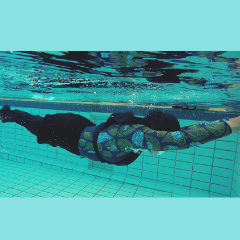
For most ladies, floating in water can be a simple and relaxing thing to do. However, for others, floating can be a little bit more challenging.
So who usually finds floating more challenging? That would have to be those who are very tall or those who are very lean/muscular with very little body fat composition.
Fats actually aid us when we are trying to float, hence ladies who have more body fat would be able to float easier compared to the lean ladies. For those who are tall or have a heavy bottom, due to the shift in the body center of gravity, the legs may end up sinking when the person tries to float.
So how do we overcome that?
- When starting to float, try not to crash into the water. Get into a floating position as gently as possible. This ensures that the water will not feel choppy and you can maintain your balance.
- Ensure that your head, body and legs are in a straight line with the feet pointed like ballerina. Imagine stretching your body out on the water. If you are in the prone (face up) position, ensure that you are looking straight at the sky with your neck in a neutral position. If you are in a supine (face down) position, ensure that your eyes are looking directly at the floor below you.
- Try not to release too much air from your lungs when you breathe. In other words, use the air in your lungs to aid in your floating. When you are swimming, only release around 50-60% of your lung capacity so that the remainder air can aid your body to float.
- When in the prone (face up) position, if you find your legs sinking, you can shorten your legs by flexing the knee and letting your legs bend (but no less than 90 degrees). Do ensure that your head, torso and upper legs are still floating in a straight line.
- Try to relax. The problem with being anxious is that it tenses your muscles and that makes you become heavier, hence sinking occurs. Try to think happy thoughts and breathe as relaxed as possible to help you float better.
